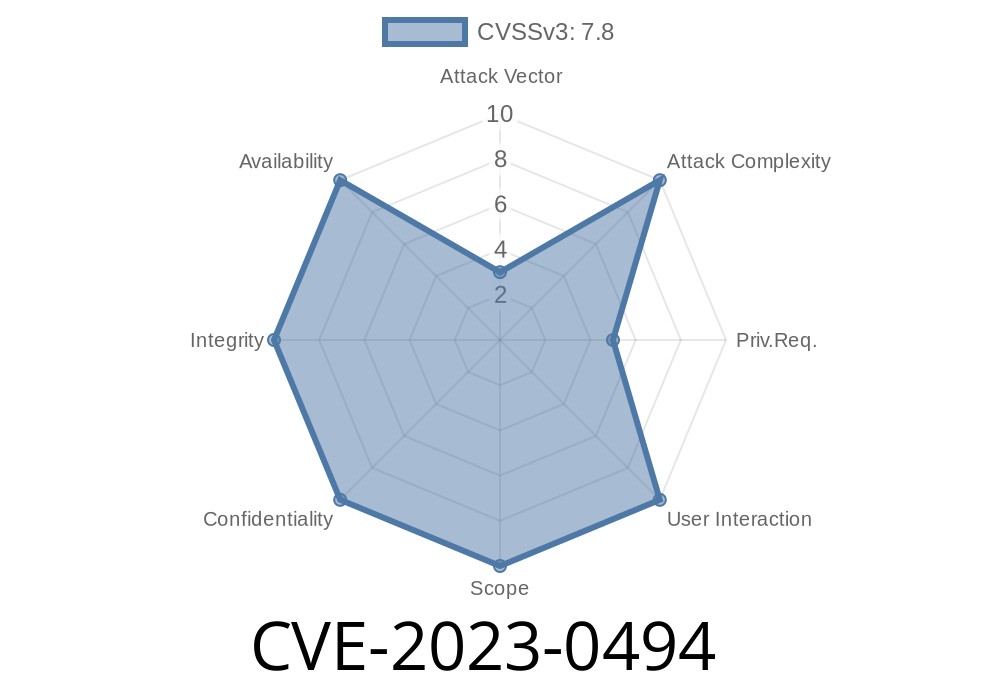Recently, a significant security vulnerability, CVE-2023-0494, was discovered in the X.Org server, a popular open-source implementation of the X Window System. This vulnerability arises due to a dangling pointer in the DeepCopyPointerClasses() function, which can be exploited through the ProcXkbSetDeviceInfo() and ProcXkbGetDeviceInfo() functions. The potential impact of this vulnerability includes local privilege elevation on systems where the X server runs privileged and remote code execution for SSH X forwarding sessions.
In this post, we will delve into the details of this vulnerability, trace the code flow, and illustrate the possible exploit scenarios. We will also provide links to the original references and discuss potential mitigation measures.
Vulnerability Overview
The issue originates from mishandling of memory allocations in X.Org Server's input device extension (XInput) when processing XKB device information. The core problem lies in the DeepCopyPointerClasses() function, which ostensibly creates a deep copy of a PointerClasses structure, but in reality can lead to the use of a dangling pointer.
Here's the snippet of the vulnerable DeepCopyPointerClasses() function
static xPointer *
DeepCopyPointerClasses(xPointer *old)
{
int n = ;
xPointer *new, *odevs, *ndevs;
if (!old)
return NULL;
for (n = , odevs = old; *odevs; n++, odevs++)
;
new = xallocarray(n + 1, sizeof(void *));
if (!new || !memcpy(new, old, sizeof(new))) {
xfree(new);
return NULL;
}
for (ndevs = new, odevs = old; *odevs; odevs++, ndevs++) {
new = DeepCopyDeviceClasses(*odevs);
if (!new)
break;
*ndevs = new;
}
*ndevs = NULL;
return new;
}
The vulnerability arises due to the inappropriate use of xallocarray() and memcpy() functions, which can result in the use of a dangling pointer. This can consequently be exploited through the ProcXkbSetDeviceInfo() and ProcXkbGetDeviceInfo() functions to read and write into freed memory, potentially leading to local privilege elevation and remote code execution.
Exploit Scenarios
There are two primary exploitation scenarios for this vulnerability. The first is local privilege elevation, achieved by maliciously exploiting the X server's privileged access, and the second is remote code execution via SSH X forwarding sessions.
Local Privilege Elevation
On systems where the X server runs with elevated privileges, an attacker can exploit this vulnerability to run arbitrary code with the same privileges. To perform such an attack, a malicious user would craft a specially crafted request that can trigger the vulnerability in DeepCopyPointerClasses(). Once the attacker gains control of the freed memory block, they can execute code with the same privileges as the X server, potentially leading to a complete system compromise.
Remote Code Execution via SSH X Forwarding
SSH X forwarding refers to the practice of forwarding X11 connections over SSH when establishing an SSH session to a remote host. Remote attackers, when forwarding their X11 connections, could exploit this vulnerability by sending specially crafted requests to the X server running on the remote host. Successfully exploiting this vulnerability could allow the attacker to execute code, read or write data, and potentially compromise the remote host.
The following mitigation measures can aid in addressing this vulnerability
- Patching the affected X.Org server installations, as recommended by the upstream maintainers in the X.Org security advisory
- Restricting the access to X server on systems running with elevated privileges or considering alternatives such as Wayland that are designed to improve privilege separation
- Minimizing the use of SSH X forwarding or using alternate solutions such as VNC or RDP to access remote desktop environments
By staying up-to-date with software patches, restricting elevated access, and carefully considering the use of SSH X forwarding, administrators can minimize the risk posed by the CVE-2023-0494 vulnerability.
Conclusion
The discovery of the CVE-2023-0494 vulnerability showcases the importance of thorough code analysis and the potential risks associated with seemingly innocuous code segments. In conclusion, while this vulnerability presents a considerable risk to affected systems, proactive mitigation measures and regular patching can significantly minimize the threat.
Timeline
Published on: 03/27/2023 21:15:00 UTC
Last modified on: 03/31/2023 14:27:00 UTC
